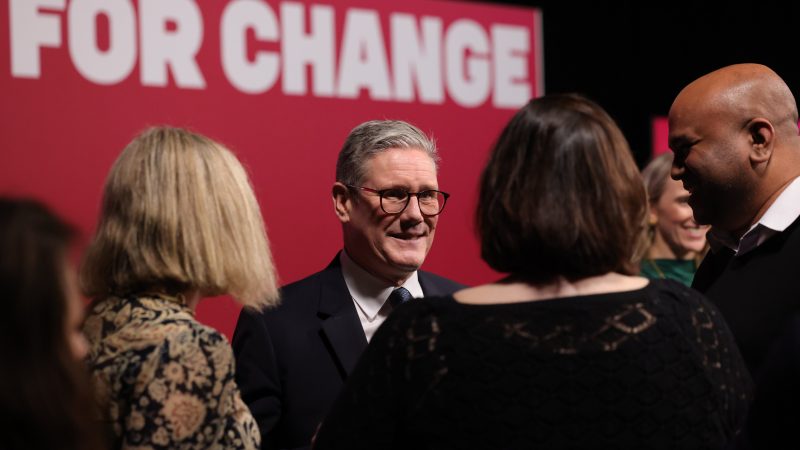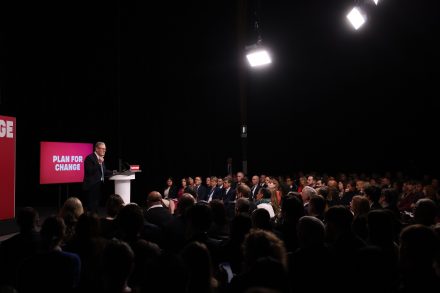
Many of the metrics unveiled in Keir Starmer’s Plan for Change had been briefed to the media in the lead-up to the launch event on Thursday.
But the new document and the launch itself still revealed much about Labour’s strategy. Here are some of our quick takeaways:
Labour is ‘doubling down’ on its missions, not dropping them
Labour downgrading its mission pledging the highest growth in the G7 to something it’s simply “aiming” for will get many headlines. So too will its acknowledgment we won’t get to 100% clean power by 2030 (read more here on why that’s not the U-turn some suggest).
There’s been criticism as well of Labour’s launch of yet another list, with one journalist dubbing the lists of missions, first steps, milestones and foundations “confusing”. I’ve written here on the many different goalposts Labour’s set itself, and why they keep changing.
For more from LabourList, follow us on Bluesky, Threads, X,Facebook, Instagram or WhatsApp.
But far from Labour dropping its missions, as some journalists have painted the milestones, Starmer was adamant Labour is “doubling down” on them – and that does seem right.
The Plan for Change document and the banners behind the Prime Minister were plastered with the missions themselves, making it much harder to ever ditch them. Starmer’s said to be hugely invested in them personally, and he repeatedly said they “remain robust” – even if not all in Labour share his enthusiasm. Like the missions or not, they seem here to stay.
Labour’s plans are more ambitious than they get credit for
Politicians face a choice between more achievable targets aimed at proving progress, and harder-to-hit ones aimed at corralling people to make progress. These seem to be a bit of both: Starmer called them “the most ambitious and credible programme for government in a generation”.
Starmer stressed the targets are “risky” as they’ll need “bold action” to deliver, and they’re aimed partly at putting a rocket up the civil service – but also showing government progress to voters.
READ MORE: What is Keir Starmer’s Plan for Change – and Labour’s six policy milestones?
One hack suggested to Starmer in the Q&A today his promise to raise real incomes was under-ambitious given most governments manage it; some will think similarly of the pledge to treat 92% of patients within 18 weeks of referral – as it’s an existing NHS target.
But Labour’s economic mission does remain ambitious even without G7-topping GDP or specifics on real income growth – as it notably promises higher living standards “in every part of the United Kingdom”.

Boosting or simply watching growth continue in Britain’s economic hotspots is one thing; delivering it in countless other areas with struggling local economies is quite another. And yet Labour’s committed itself to growth in per-head incomes in every single region.
Delivering GDP growth, the most-used metric to date, would also be much easier than the GDP per capita growth Labour is promising.
Immigration has helped past governments raise GDP without boosting productivity; GDP per capita growth likely requires harder reforms to make Britain more productive – and it’s a challenge many advanced economies have struggled with.
READ MORE: Plan for Change: ‘Voters will reward Labour in 2029 if Starmer fixes public services’
Ditto on housebuilding, the government will face enormous political, legal, logistical and social barriers to its promise of 1.5 million homes, a pledge it has chosen to elevate on rather than downgrade.
The shift to clean power is a huge endeavour too that doesn’t tend to get enough airtime.
As the Energy Secretary Ed Miliband told LabourList in a brief interview at today’s launch: “These are bold priorities that will change the country for the better…the notion that it’s really easy: far from it.”
In a world with such low trust in politics, committing to concrete results is admirable as well – as long as Starmer sticks to them more than he stuck to his 10 leadership pledges.
Tony Blair casts a long shadow
Looming large over Labour’s plans is Tony Blair. For one, the launch was held in the Beaconsfield constituency the former PM first stood in (in the only election he ever lost, ominously).
Some of those who worked on the document and launch were part of the New Labour machine, like Pat McFadden. But above all, the decision to prioritise single precise metrics for some public services revives a key part of Blair’s approach to government.
Such targeting has its critics, as it comes at a cost in deprioritising other areas and risking perverse incentives – remember the controversy over things like some schools focusing all their energy on teenagers on the C/D grade borderline, to hit metrics for the number of A* to C grades. Journalists and the health sector have voiced alarm already about waiting list targets, fearing other areas like A&E could pay the price.
READ MORE: ‘6 milestones, 5 missions, 3 foundations: Have Labour’s lists changed too much?’
But Starmer’s reasoning is understandable and clear in his speech: the aim is to cement Whitehall’s focus “not on the distraction of Westminster, but the long-term good of our country” (and of course the tangible results Labour wants to be able to show come the next election campaign). And you can’t make everything a priority.
Some in Westminster have mocked Labour’s latest “reset”, but this document seems just as, if not more, aimed at civil servants as voters. Departments get pulled in many directions; this is a serious attempt to keep the destination clear.
Shades of Bond – and McSweeney

Starmer’s speech included mocking the idea working “a couple of shifts in McDonald’s” made Kemi Badenoch working-class. “By that logic, if I keep coming back here, I could be the next James Bond,” he added.
The line was doubtless meticulously planned icing on the cake for journalists (including us) looking for ways to spice up their coverage, the cake being Labour holding the event itself at Pinewood Studios, where many Bond films were filmed.
It’s a gimmick, but like Ed Davey’s more extravagant stunts, the potential for Bond metaphors and montages of mission-man Starmer boosts his chances of getting high up the news bulletins, particularly when much of Labour’s plan was known in advance.
READ MORE: ‘If Labour achieves its six milestones, it will have a proud record. The challenge is meeting them’
That choice, and the nature of the event itself, are just the latest sign of a small but striking tilt from governing mode back towards campaign mode at the top. Many will attribute that to the influence of ex-campaign chief Morgan McSweeney, following his recent promotion.
We had a dark backdrop full of coloured mission signs uncannily similar to Labour’s pre-election First Steps launch. We had videos of and then speeches by voters talking about the different Labour makes to their lives, and upbeat music blaring. For attending hacks, it felt much like a Labour campaign event, rather than an official government event.
An under-the-radar new inflation pledge
The Plan for Change notably includes a pledge to maintain “low and stable inflation”, which interestingly hasn’t picked up masses of attention.
Given how many factors affect inflation beyond a government’s control, how challenging former Prime Minister Rishi Sunak found it to hit his own inflation pledges, and how inflation has frustrated Labour government’s past, it’s actually a big gamble.
SIGN UP: Get the best daily roundup and analysis of Labour news and comment in our newsletter
It will mean even more scrutiny of its decisions on issues like public sector pay rises and green investment spending.
That said – inflation played a big role in undermining former President Joe Biden’s electoral prospects, no government can ignore it and keeping it low and stable is one arm of government’s job anyway – albeit an independent arm in the Bank of England.
Read more about the Plan for Change:
- ‘6 milestones, 5 missions, 3 foundations: Have Labour’s lists changed too much?’
- ‘If Labour achieves its six milestones, it will have a proud record. The challenge is meeting them’
- What is Keir Starmer’s Plan for Change – and Labour’s six policy milestones?
- ‘Why Keir Starmer should embrace populism ahead of the next election’
- Plan for Change: ‘Voters will reward Labour in 2029 if Starmer fixes public services’
- ‘Starmer’s ‘Plan for Change’ speech needs to deliver real solutions or face testing voters’ patience’
- Plan for Change: ‘If early years is key for the PM, we need a revamped Sure Start’
- Starmer poised to unveil ‘measurable milestones’ in Labour’s missions for government
- SHARE: If you have anything to share that we should be looking into or publishing about this story – or any other topic involving Labour– contact us (strictly anonymously if you wish) at [email protected].
- SUBSCRIBE: Sign up to LabourList’s morning email here for the best briefing on everything Labour, every weekday morning.
- DONATE: If you value our work, please donate to become one of our supporters here and help sustain and expand our coverage.
- PARTNER: If you or your organisation might be interested in partnering with us on sponsored events or content, email [email protected].




More from LabourList
‘Like changes to winter fuel allowance, lifting the two-child cap may be easy in Parliament — and risky everywhere else’
‘No racist is going to make me feel I don’t belong’: Shabana Mahmood on resilience, faith and public service
Delivering in Government: your weekly round up of good news Labour stories